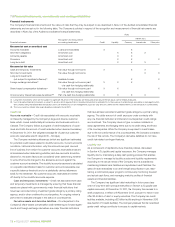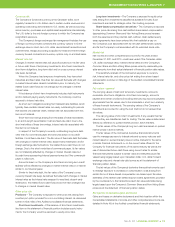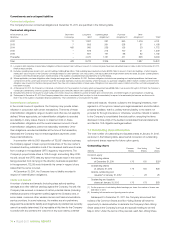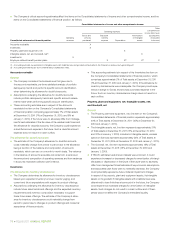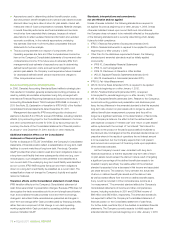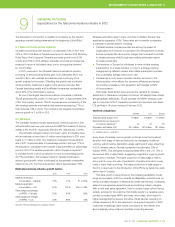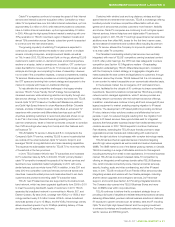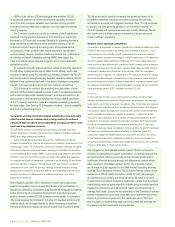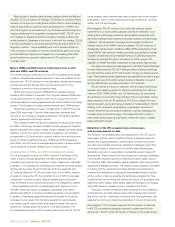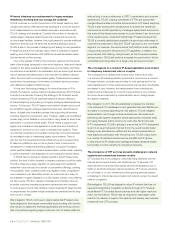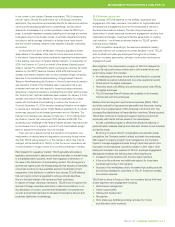Telus 2011 Annual Report Download - page 85
Download and view the complete annual report
Please find page 85 of the 2011 Telus annual report below. You can navigate through the pages in the report by either clicking on the pages listed below, or by using the keyword search tool below to find specific information within the annual report.
TELUS 2011 ANNUAL REPORT . 81
MANAGEMENT’S DISCUSSION & ANALYSIS: 9
Cable-TV companies continue to increase the speed of their Internet
services and intensify customer acquisition offers. Canada’s four major
cable-TV companies have over 5.6 million Internet subscribers, up from
approximately 5.4 million in 2010, while telecommunications companies
have 4.4 million Internet subscribers, up from approximately 4.3 million
in 2010. Although the high-speed Internet market is maturing with over
76% penetration in TELUS’ incumbent region in Western Canada and
almost 75% penetration across Canada, subscriber growth is expected
to continue over the next several years.
The growing popularity of watching TV anywhere is expected to
continue as customers demand the ability to view content on multiple
screens, including computers, smartphones and tablets, as well as
on TVs. In early 2012, TELUS launched Optik on the go, allowing TELUS
customers to watch certain on-demand movies and shows anywhere,
anytime on a laptop, tablet or smartphone. In addition, OTT content pro-
viders like Netflix for movies and Hulu for TV shows and movies, as well
as Apple and Google, are competing for share of viewership. However,
it is not clear if this com petition replaces, or simply complements, existing
TV services. Wireline service providers are monitoring developments in
the OTT space and evolving their content strategy and approach to the
market to compete with these non-traditional offerings.
To help alleviate the competitive challenges in the legacy wireline
services, TELUS’ Future Friendly Home® strategy has successfully
increased revenues, while enhancing retention and loyalty through mul-
tiple service offerings. In mid-2010, the Company launched new TELUS
brands Optik TV (IP TV based on the Microsoft Mediaroom platform)
and Optik High Speed Internet in urban Alberta and British Columbia
markets, and later in Eastern Quebec. Optik offers an enhanced TV
experience with premium and differentiated services such as PVR
Anywhere (enabling customers to record and play back shows on up
to six TVs in the home), Remote Recording (enabling customers to
use their smartphone, tablet or Internet-connected computer to schedule
their PVR recordings when away from home) and other features such
as Facebook TV.
TELUS Satellite TV service in Alberta and B.C. complements the
Company’s Optik TV service, enabling TELUS to serve households that
are outside of the urban/suburban Optik TV network footprint, and
leverages TELUS’ strong distribution and mass marketing capabilities.
This expands the addressable market for TELUS TV to more than 90%
of households in the two provinces.
In 2011, TELUS added 196,000 new TV subscribers and increased
its TV subscriber base by 62% to 509,000. TELUS’ primary Western
cable-TV competitor increased the speeds of its Internet services and
launched a new residential media hub/gateway in 2011, with some
similar features such as whole-home PVR. In addition, in late 2011 and
early 2012 this competitor continued intense promotional activity and
incentives, lowered bundled prices and mass advertised to win back
customers and protect its shrinking cable-TV subscriber base.
TELUS’ new IP-based services are supported by its wireline broad-
band network, which has been upgraded significantly from 2009 to 2011
to meet the evolving bandwidth needs of customers. In 2011, TELUS
expanded its broadband network in communities in Alberta, B.C. and
Eastern Quebec. By early 2012, coverage with ADSL2+ or VDSL2 tech-
nology reached nearly 2.3 million homes. ADSL2+ allows broadband
download speeds of up to 15 Mbps, and the VDSL2 technology overlay
allows download speeds of up to 30 Mbps (enabling delivery of three
simultaneous HD signals into the home).
Combined with wireline local and long distance, wireless and high-
speed Internet and entertainment services, TELUS is increasingly offering
bundled products to achieve competitive differentiation with an inte-
grated set of services that provides customers more freedom, flexibility
and choice. Cable-TV companies are continuing to roll out higher-speed
Internet services, Internet telephony and digital cable-TV services to
support growth. In 2011, TELUS’ TV and high-speed Internet net subscriber
additions more than offset NAL losses for the first time in seven years,
as its broadband investments and bundled offers including its premium
Optik TV service, allowed the Company to improve its position relative
to its main cable-TV competitor.
The Canadian broadcasting industry has become more vertically
integrated, with most of TELUS’ competitors owning broadcast content.
In 2011, after public hearings, the CRTC set clear safeguards to ensure
competition (see Section 10.3 Regulatory matters – Broadcasting
distribution undertakings). TELUS’ differentiated approach, consistent
with the Company’s content strategy, is to aggregate, integrate and
make accessible the best content and applications to customers, through
whichever device they choose. TELUS believes that it is not necessary
to own content to make it accessible on an economically attractive basis.
In the business market, the convergence of IT and telecommuni-
cations, facilitated by the ubiquity of IP, continues to shape competitive
investments. Telecommunications companies like TELUS are providing
network-centric managed applications, while IT service providers are
bundling network connectivity with their software as service offerings.
In addition, manufacturers continue to bring all-IP and converged (IP plus
legacy) equipment to market, enabling ongoing migration to IP-based
solutions. The development of IP-based platforms providing combined
IP voice, data and video solutions creates cost efficiencies that com-
pensate, in part, for reduced margins resulting from the migration from
legacy to IP-based services. New opportunities exist for integrated
solutions that have greater business impact than traditional telecommu-
nications services. In 2012, TELUS expects to continue Customers
First initiatives, extending the TELUS future friendly promise to large
organizations across Canada and collaborating with customers to
deliver the right solutions to businesses with complex technology needs.
TELUS has launched an expanded series of solutions targeting
specific high-value segments as well as small and medium businesses
(SMB). The SMB market is one of the fastest-growing markets in Canada.
TELUS is investing in a range of affordable solutions for this segment,
including everything from email to web applications. In the small business
market, TELUS has countered increased cable-TV competition by
offering an integrated small business bundle called TELUS Business
One, which includes connectivity (voice, Internet and email services),
security, hosting, audio and video conferencing, and other IP-based
tools.
In 2011, TELUS introduced Future Friendly Office service bundles
integrating wire less and wireline with two flexible packages, including
anytime device upgrades and changes to services, 24/7 technical
support, and one bill (see Section 2.2 Providing integrated solutions).
The Company also opened nine TELUS Business Stores and more
than 40 SMB zones within corporate stores.
TELUS continues to believe that its consistent strategic focus on
providing a full suite of valuable and reliable telecommunications services;
delivering differentiated, premium national business solutions in data and
IP; exposure to growth services such as wireless, data and IP, including
Optik TV and Optik High Speed Internet; and the ongoing investment
to enhance its wireless and broadband networks, position the Company
well for revenue and EBITDA growth.



